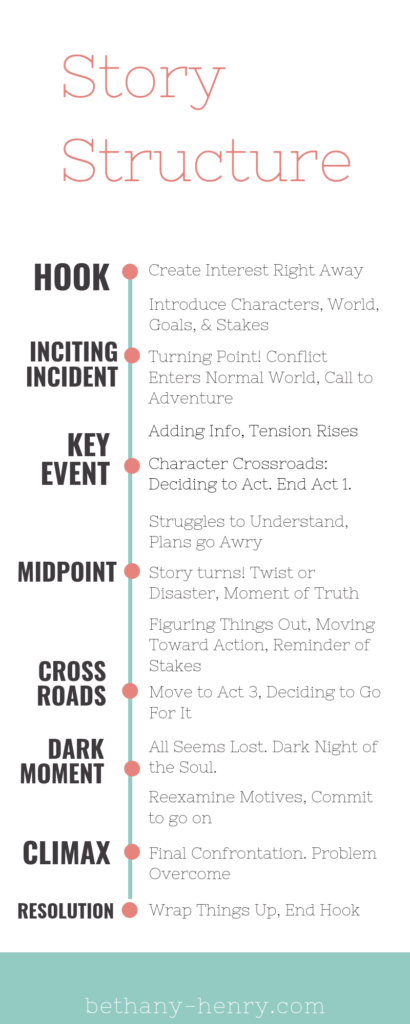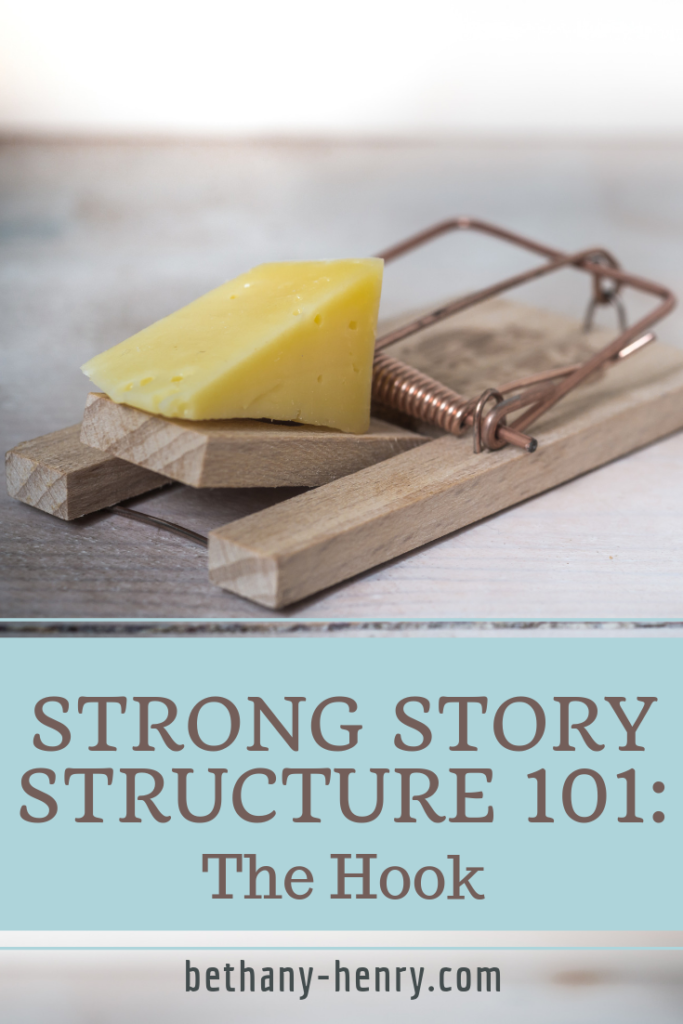Story structure is the framework that makes a story “work.” When utilized, it can provide a firm foundation to make stories more powerful and allow readers to resonate with them.
We’ve looked earlier at an outline of the core elements that make up strong stories.

Today we’re digging a bit deeper into a story’s “hook” and what it should look like in our writing.

Strong Story Structure: The Hook
The hook is where we begin our story! This is the first scene, maybe even the first sentence of our story. And it is critical for several reasons.
Perhaps most obviously, the hook needs to engage the reader immediately.
When picking up a new book, readers will usually only look at the first few pages, or possibly even the first few sentences, to see whether they think they’ll like it. Therefore, it’s extremely important to catch their interest quickly!
How to Catch a Reader’s Interest:
- Through action
It doesn’t always need to be a life or death fight, but something happening can make readers want to find out what happens next/whether a character is successful. - Through an engaging character
If readers connect with our main character (humor and empathetic situations are both great for this) then they will be more invested in reading more. - Through raising questions
If we introduce questions that pique a reader’s interest, they will be more inclined to read further to learn more.
Shy away from:
- Weather, alarm clocks, or dreams
Cool idea but overdone. - Extended backstory or unnecessary prologues
Readers often aren’t invested enough yet to care about backstory. - Extended internal thoughts or “life as normal” introductions
They tend to be boring for readers since they don’t love our characters as much as we do… yet.
Obviously each book is different and there are exceptions to every rule. This is merely a guideline to keep in mind to help us create strong starts and hook our reader’s interest!

Along with catching the reader’s interest, the beginning pages of a story should also:
- Introduce the main character
- Introduce the world they are in
- Introduce the goals and stakes of the story
1. Introducing the Main Character
If we can introduce our main character (protagonist) to the reader right off the bat, that can help the reader immediately get connected and invested in the story.
A characteristic moment is when a character is put in a position where they show who they are, what’s important to them, their strengths/weaknesses, and/or their personality.
This is a powerful moment that is great for introducing characters.
For instance, maybe a hot-tempered chef is introduced in their kitchen when their bus-boy knocks over a tray of clean utensils – this will be an opportunity to show their irritation and response immediately in the story. Or maybe an animal loving college student can be introduced as they skip class to take care of a stray puppy.
Whatever it is, we want to immediately give our reader an idea of who our main character is.
2. Introducing our Setting
Is our story set in a small town or an international city? Show that. And show how the main character reacts to the setting as well. It should all play off each other.
For more reading on setting check out Worldbuilding for Writers and my pinterest worldbuilding resources.
3. Introducing our Problem
The last big element to include at the beginning of our novel is any problems that will need to be solved. Sometimes the bigger story goals and stakes aren’t revealed until later on (see the inciting incident and midpoint), but they can still be foreshadowed or a smaller goal can be introduced to start off with.
They should have something that they want. As Kurt Vonnegut said, “Every character should want something, even if it is only a glass of water.
We need to introduce a problem right away. This makes people want to read more to find out if it gets solved.
There should always be questions and problems left unanswered in our story until the very last page. (And sometimes even then!!)
So the hook needs to immediately grab the reader’s attention, hopefully within the first few sentences, and then introduce the protagonist, setting, goals, and stakes.
No pressure, right? 😉
The good news is that there are lots of resources out there to help us practice creating strong story starts.
For Further Reading:
10 Ways To Hook Readers (and Reel Them in for Good) – Writer’s Digest
How to Find Exactly The Right Story Hook – Helping Writers Become Authors
Hooked: Write Fiction That Grabs Readers at Page One and Never Lets Them Go – Les Edgerton
This is my top book recommendation on story hooks and keeping readers engaged. I am an affiliate for this book (meaning I’ll earn a small commission if you buy it through my link). It’s a fun, quick, and informative read as Edgerton shows us he knows how to practice what he preaches.
The good news is we can go back and revise our hook as many times as we need to later on.
In fact, it generally isn’t a great idea to spend tons of time to perfect our hook before we finish our story.
Why not?
Because often it isn’t until we’ve finished the story that we’re able to set up the beginning hook properly. This is because setting up character arcs will influence our introduction, as well as foreshadowing and introduction of the story’s main problems and themes.
We don’t want to get bogged down with revising our hook and neglect to write the rest of the story.
Plus we don’t want to waste tons of time on a hook that will just need to be changed later.
So do yourself a favor. Jot down any cool hook ideas you have and keep these principles in mind. And then forget about it until revision time rolls around.
Then it will be time to come on back here and craft a strong hook that will serve your story and capture your reader’s attention.
What about you? Do have an awesome hook for your story? Share your first sentence or two below!





